Virginia is a beautiful and diverse state filled with equally diverse flora and fauna. These 22 caterpillars in Virginia barely scratch the surface of the number of caterpillars that inhabit the Old Dominion State. Some of those 22 caterpillars are venomous, meaning they can bite or sting, and their toxin defense mechanism will help remind you or a predator why you shouldn’t mess with these little guys. A couple packs a nasty punch, and one is the most venomous caterpillar in North America.
Most of the caterpillars in this article are not strictly located in Virginia. Many are found throughout the continent or, minimally, that part of the country. Remember, caterpillars are at the bottom of the food chain and need whatever defense tactics they can scrape up. Without further ado, let’s meet the caterpillars.
Where to Find Caterpillars in Virginia
Virginia is incredibly diverse, with parks, forests, mountains, and other outdoor wonders. Many caterpillar types are found in forests, especially along riverbank foliage, trees, and shrubs. Eastern Virginia is home to most puss caterpillars, but the dense forests and mountains in central and western Virginia are home to many others. Central Virginia has many reports of luna moth caterpillar sightings. No matter where you are in Virginia, if you’re in a wooded area with plenty of deciduous trees or fruit trees, you are likely surrounded by caterpillars in the warmer months.
Poisonous/Venomous Caterpillars
1. Saddle-Back Caterpillar (Acharia stimulea)

The saddleback caterpillar looks like a cartoon with its big spiky antennae and racing saddle.
©Hagit Berkovich/Shutterstock.com
Appearance: Brownish-pink body with a green “blanket” and brownish-pink or grey saddle with a white ring around it. They are covered with horn-like appendages with venomous spikes.
Size: 1 inch
Habitat: Deciduous trees, grass, holly, corn, apple, pear, cherry, rose, basswood, chestnut, oak, and plum in forests in suburban and rural communities
Diet: Maples, apple, blueberry, spicebush, dogwoods, grape vines, sunflowers, gladiolas, and crape myrtle
Dangers: The stinging venomous spines cause immediate pain and swelling that spreads to the lymph nodes. It can cause nausea in the first hours after the sting. In sensitive people or those who are allergic to bee stings, the sting from this caterpillar can cause anaphylactic shock.
Interesting Fact: They have white or yellow spots near their face that mimics eyes to scare off predators.
2. Hagmoth or Monkey Slug (Phobetron pithecium)
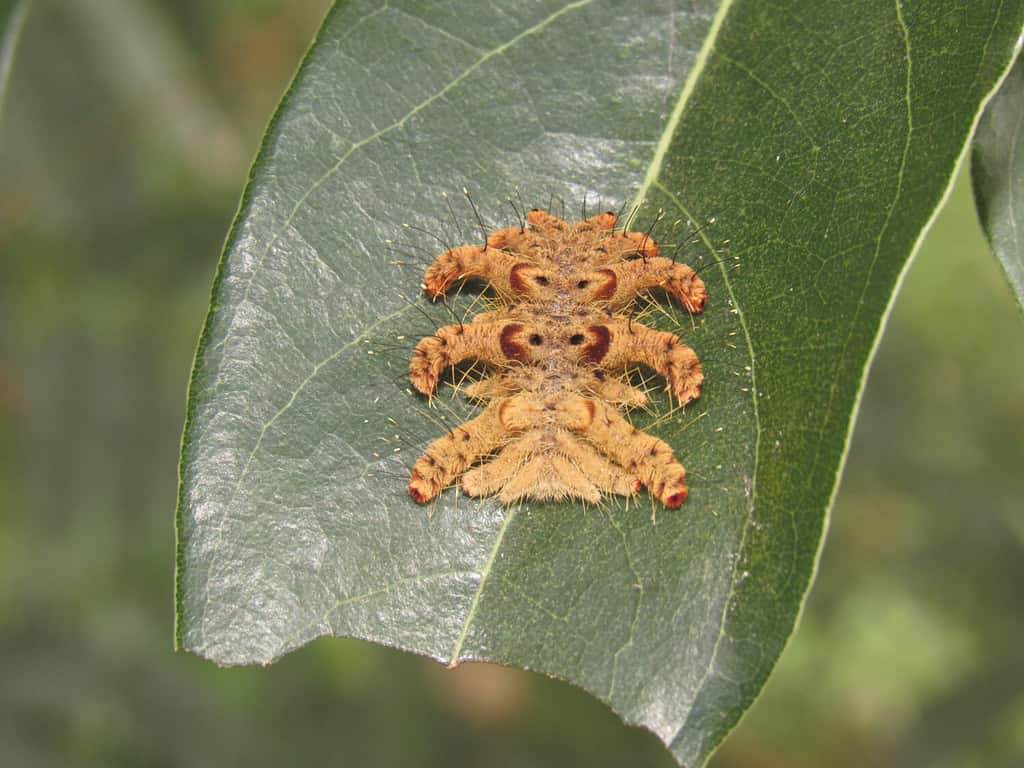
The monkey slug caterpillar is not dangerous but can cause an allergic reaction in sensitive people.
©Fabio Ara/Shutterstock.com
Appearance: Covered with short brown, black or tan hair with many spines covering its body. The midsection has a darker brown face-looking design. The underside has squishy suction cup legs. The long leg-like appendages mimic tarantula legs.
Size: .78 – 1.10 inches long
Habitat: Oak, hickory, apple, cherry, ash, birch, chestnut, dogwood, persimmon, willows, and other woody plants. They can infest shrubs and trees.
Diet: Woody plants, persimmons, oak, chestnuts, dogwood, birch, hickory, and willows
Dangers: They are not poisonous or venomous but can irritate the skin of sensitive people.
Interesting Fact: One of their defense tactics is dropping one of their appendages when attacked.
3. Hackberry Leaf Slug (Norape ovina)

Hackberry Leafslug or White Flannel Moth can vary somewhat in coloring but the long wispy hairs help identify it.
©judygva (back in town and trying to catch up) / CC BY 2.0 – License
Appearance: Off-white to beige or brown body with a big brownish-purple spot on its back and has six long wispy tufts of stinging hairs on each segment of its body.
Size: 3/8 – 1 inch long
Habitat: Hackberry trees, honey locust, maple, beech, black locust and mimosa.
Diet: Hackberry leaves are the preferred food. Red maple and redbud are also favorites.
Dangers: The hollow venom-filled spines of the hackberry leaf slug can break off the skin and cause severe irritation. The sting feels like a bee sting; the pain lasts a few hours and can blister. The swelling lasts several days. Using duct tape to remove leftover spines in the skin is highly recommended for all stinging caterpillar wounds.
Interesting Fact: Hackberry leaf slugs incorporate their venomous spines into their cocoon’s outer layer to protect the pupa from predators.
4. Io Moth (Automeris io)
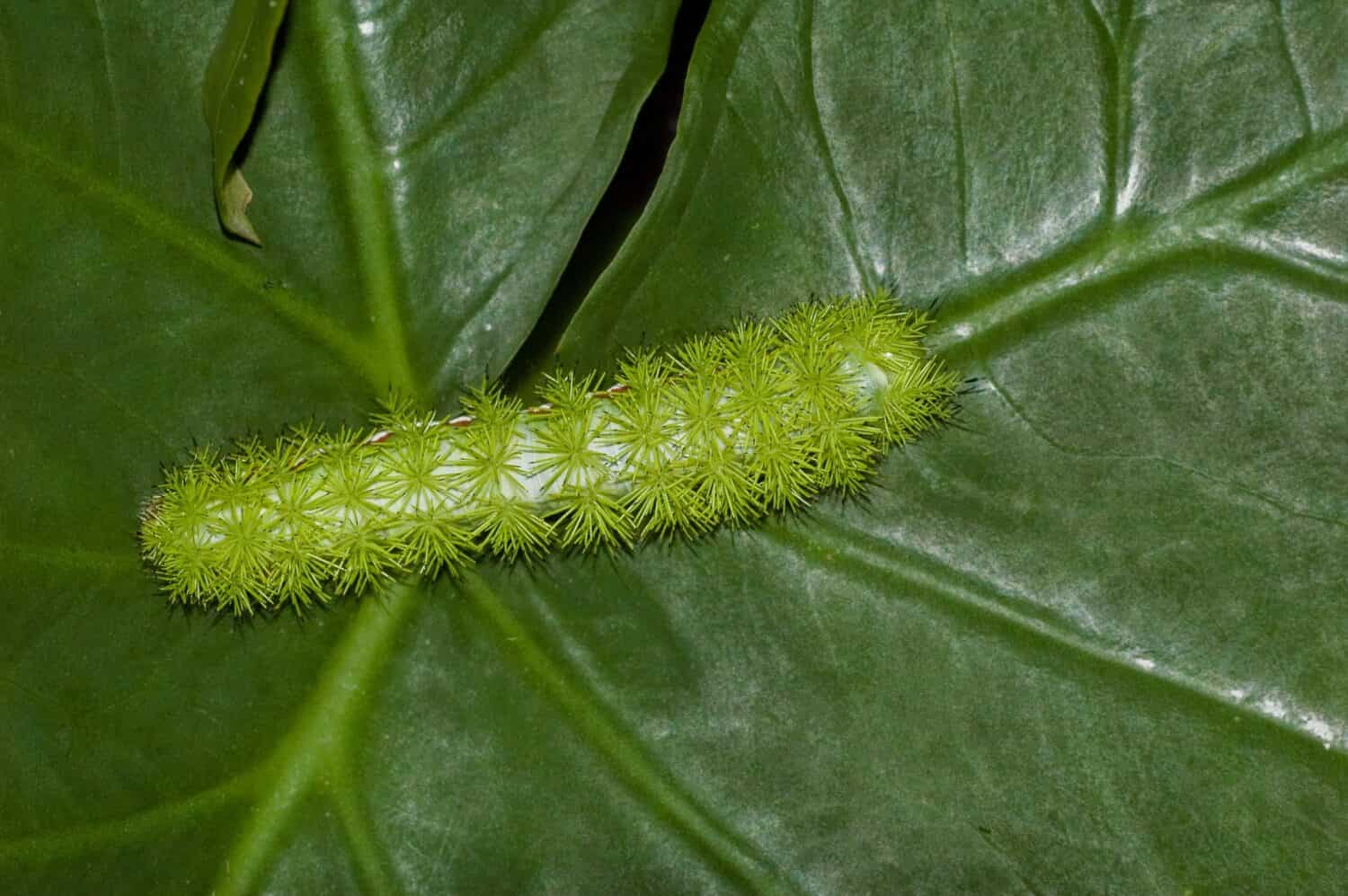
When the Io caterpillars are young, they stay in groups and can sometimes be seen “marching” in a line.
©Donna Bollenbach/Shutterstock.com
Appearance: Yellowish-green to bluish-green with a red and white stripe along their sides. They are covered in sharp spines.
Size: 2 – 2.5 inches long
Habitat: Deciduous forests, thorn scrub, and suburban areas
Diet: Redbud, hackberry, mesquite, willow, currant, blackberry, and pear
Dangers: Stinging venomous spines covering their body often break off in the skin, causing severe pain and swelling. The pain will last hours and then taper off, but the swelling will remain for days.
Interesting Fact: The Io moth is called the peacock moth because of its striking coloration and large spot on each wing.
5. Buck Moth (Hemileuca maia)

Buck moth caterpillars live in groups until they reach the fourth instar.
©iStock.com/Oleg Marchak
Appearance: Black or dark reddish-brown with prickly spines covering their bodies. Sometimes appear almost white when covered with tiny white spots.
Size: 2.5 inches long
Habitat: Oak forests and leaf litter, occasionally digging several inches into the soil before pupating.
Diet: Shrubs and trees in the oak family; live oak, blackjack oak, and dwarf chestnut oak.
Dangers: The prickly spines contain urticating fluid, which can cause severe irritation to the skin in the form of an itchy rash. The effects of the venom can last over a week. The toxin spreads to the lymph nodes quickly. It can cause anaphylaxis in severe allergic cases.
Interesting Fact: Buck moths do not have any form of working mouth and cannot feed in that form.
6. Southern Flannel Moth or Puss Caterpillar (Megalopyge opercularis)
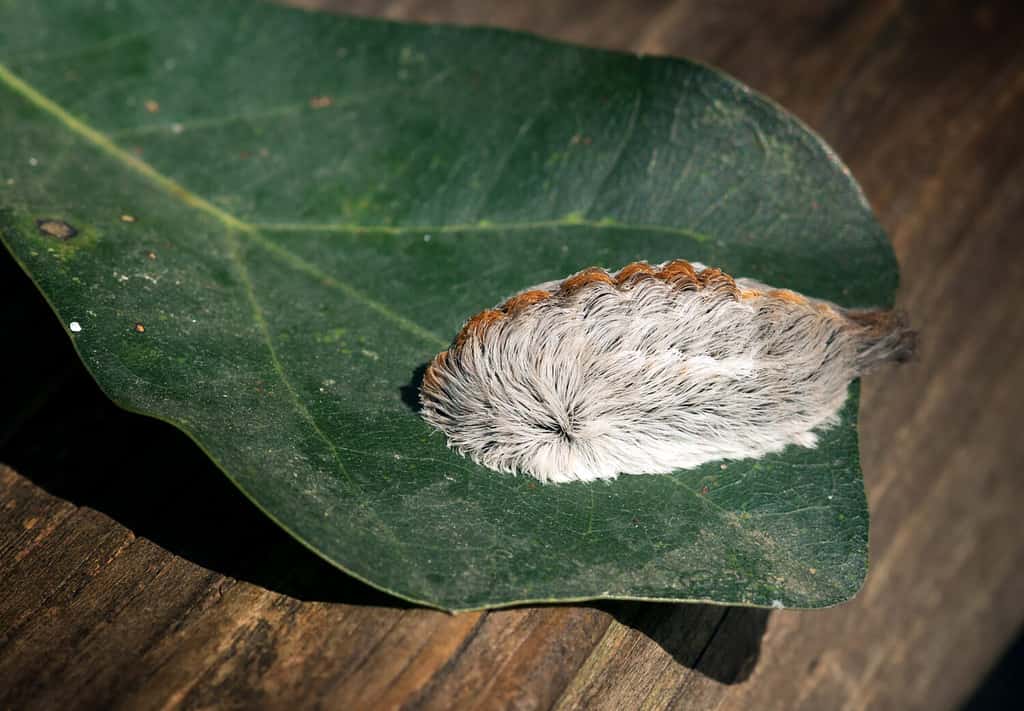
Often compared to a toupee, the puss caterpillar is not someone you want to mess with.
©IrinaK/Shutterstock.com
Appearance: Think coating of long hair covers the body of the caterpillar. They vary in color and tend to have a darker color that runs down the center of their back and a tail the same color.
Size: 1.6 inches long
Habitat: Oak, elm, and wild plum, garden plants such as roses and types of ivy
Diet: Prefer elm and oak leaves but will munch on most things with leaves, including holly
Dangers: These are the most dangerous caterpillars to humans in the United States. They have stinging hairs that immediately cause burning pain and a grid-like rash where the spines touch the skin. Systemic manifestations, including headache, fever, nausea, vomiting, tachycardia, low blood pressure, seizures, abdominal pain, muscle spasms, and convulsions, can also occur.
Interesting Fact: They are named such because their hair looks soft, like a cat’s fur.
7. White-Marked Tussock Caterpillar (Orgyia leucostigma)

The white-marked tussock caterpillar is one insect you should avoid.
©Satyashutter/Shutterstock.com
Appearance: The white-marked tussock caterpillar looks almost like it is wearing tribal paint. It has a white body, with a brown streak of short hairs down the center of its back, black circles with two yellow dots containing urticating hairs near the head, followed by a line of yellow dots with black dots inside along the border of the brown streak.
Size: 1 – 1.5 inches long
Habitat: They spend their time on the tree or plant they choose and leave only when they can fly away.
Diet: They munch on many different types of plants and trees, both deciduous and coniferous, including hackberry, cherry hemlock, willow, alder, apple, birch, rose, elm, black locust, fir, hackberry, hickory, larch, spruce, chestnut, and oak.
Dangers: Touching these little fuzzballs is out of the question since one touch can cause severe skin irritation and hives. Even touching a cocoon can cause irritation! They do not have venom, but the long black hairs contain a neurotoxin, which can cause serious side effects if eaten. Your stomach will be upset with diarrhea, vomiting, and cramping. If an animal eats one, it can cause the same symptoms. In severe human and animal cases, the ingester of the caterpillar can experience seizures, respiratory paralysis, and death. Not all caterpillars in Virginia are safe.
Interesting Fact: Much like New World tarantulas, the caterpillars have urticating hairs that cause an allergic reaction in some people. You don’t want to get one in your eyes.
Nonpoisonous/Nonvenomous Caterpillars
8. Viceroy Caterpillar (Limenitis archippus)
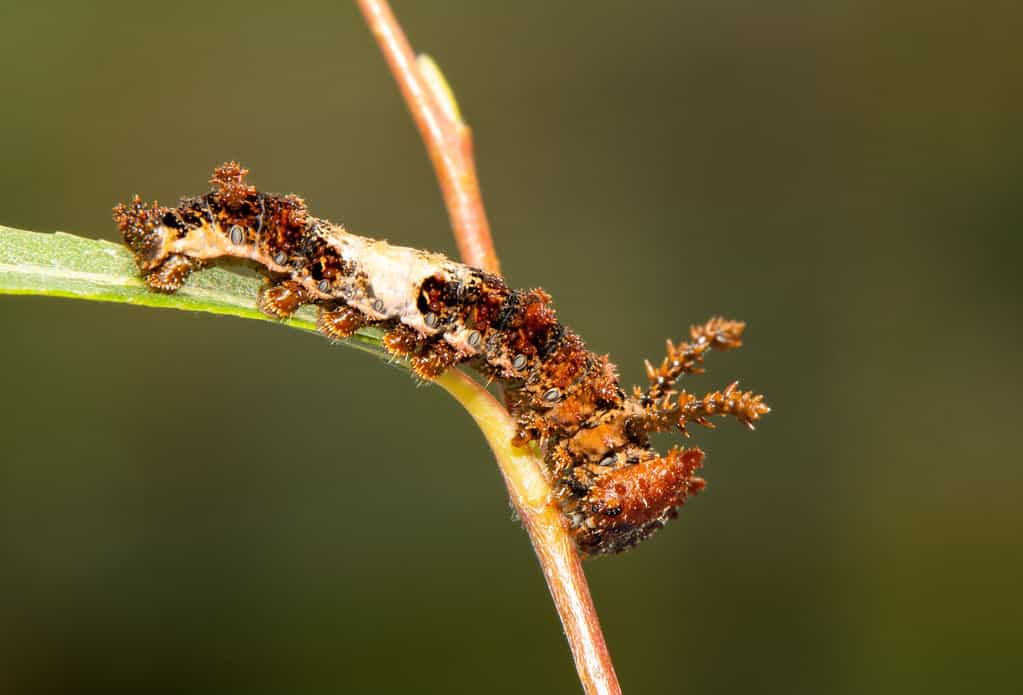
Viceroy from birth to pupa stage always appears to be bird droppings but looks similar to the
monarch butterfly
after the metamorphosis is complete.
©Sari ONeal/Shutterstock.com
Appearance: Mottled brown or green; has creamy blotches and two knobby horns on its thorax, keeping it disguised as bird droppings.
Size: 1.5 – 2 inches long
Habitat: Wetland areas along rivers, lakes, and streams where willows grow
Diet: Willows, cottonwoods, and poplar tree leaves
Dangers: Harmless to humans but, if eaten, will cause severe stomach upset in whatever eats it
Interesting Fact: These butterflies can create hybrids by mating with other types of butterflies.
9. Eastern Tent Caterpillar (Malacosoma americanum)
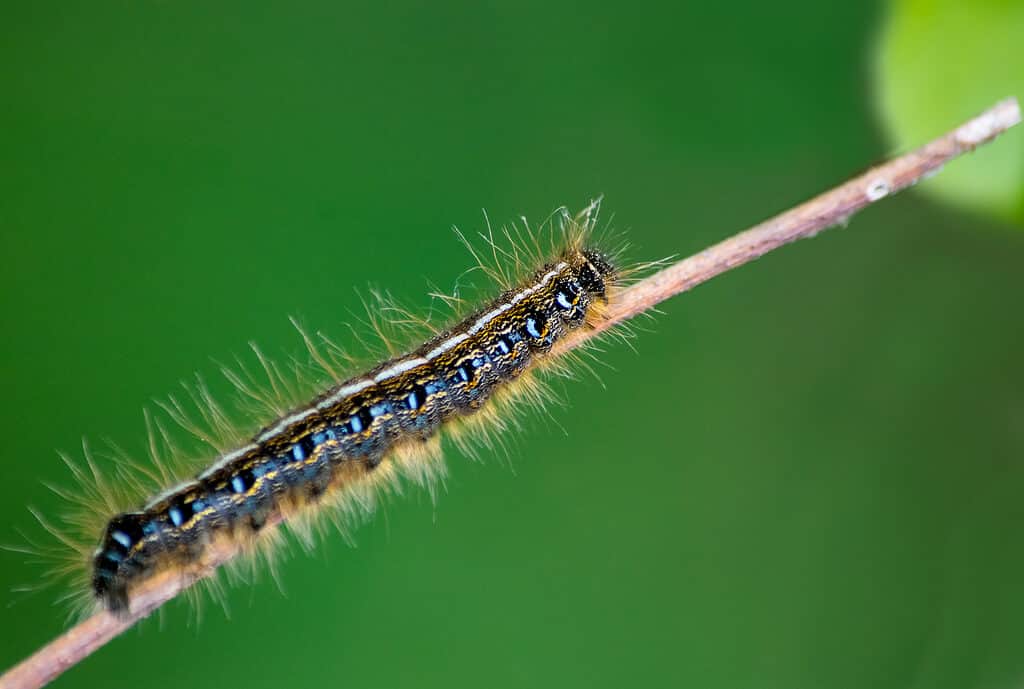
These non-tree-harming caterpillars are often confused with fall webworm nests.
©K Quinn Ferris/Shutterstock.com
Appearance: Fuzzy blackish caterpillars with a white stripe down their back, brown and yellow lines along the sides, and a row of oval blue spots on the sides.
Size: 2 inches long
Habitat: Most types of trees, but prefer wild cherry, apple, crabapple, hawthorn, maple, cherry, peach, pear, and plum.
Diet: Leaves from the trees in their habitat
Dangers: They are not harmful to humans or animals. They don’t cause damage to their host trees either.
Interesting Fact: Tent caterpillars are social creatures, so they create communal nests in trees.
10. Woolly Bear or Isabella Tiger Moth Caterpillar (Pyrrharctia isabella)
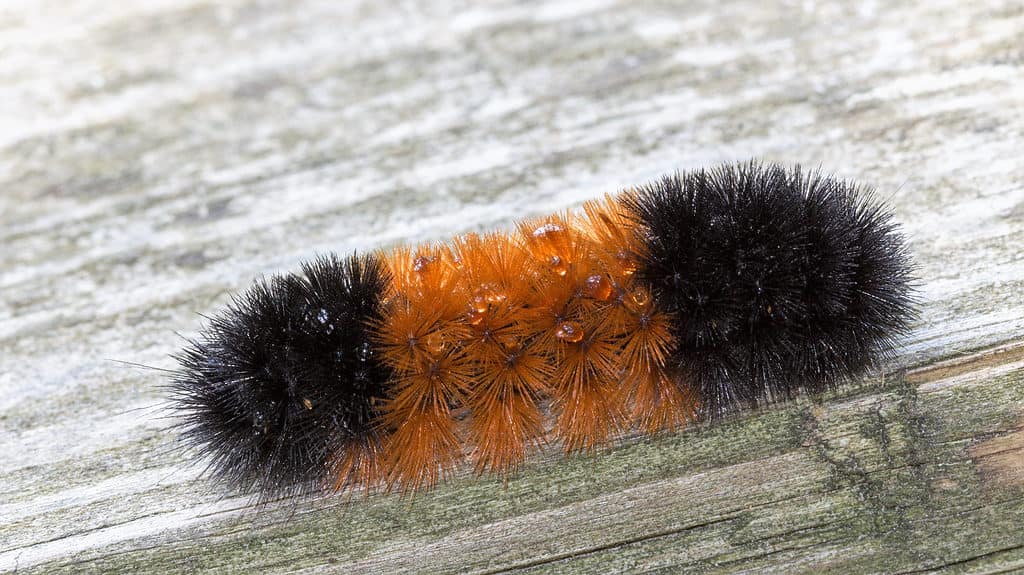
Many people believe that the color or length of color on a wooly bear predicts the winter.
©Kimberly Boyles/Shutterstock.com
Appearance: Fuzzy and black with an orange-brown saddle
Size: 2 inches
Habitat: Urban areas, forests, meadows, fields, gardens and farms
Diet: Maple and elm trees, grasses, sunflowers, clovers, and more.
Dangers: They are harmless and will curl into a tight ball if handled to play dead.
Interesting Fact: There is some truth to the wooly bear predicting the weather. Wetter than average weather tends to cause longer black bands. Older caterpillars have longer orange-brown bands.
11. Giant Leopard Moth Caterpillar (Hypercompe scribonia)
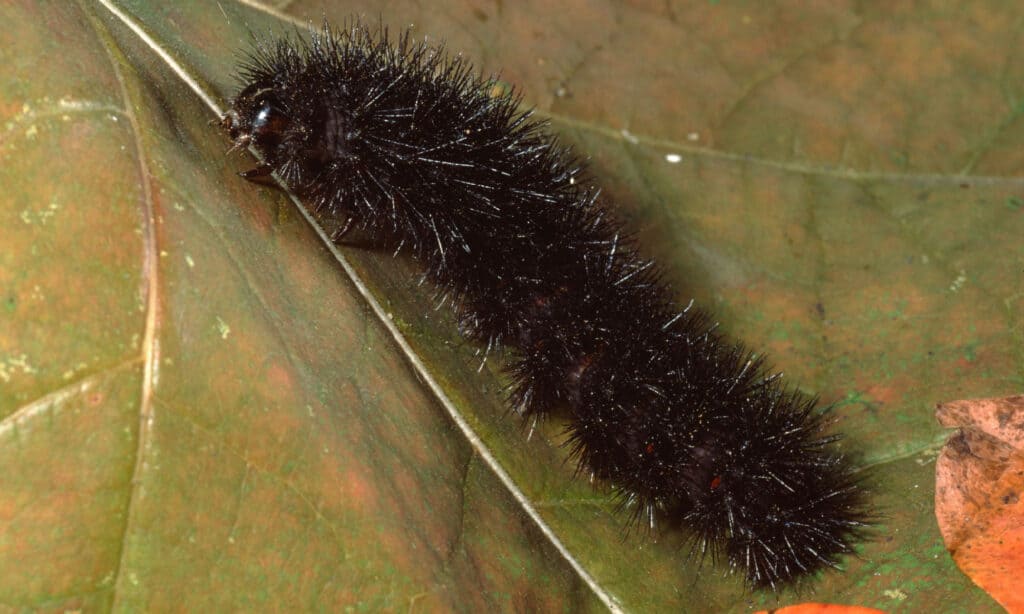
The giant
leopard
moth caterpillar is sometimes confused with the wooly bear caterpillar.
©iStock.com/Weber
Appearance: Black spiky caterpillars with red stripes under their black spikes at segments
Size: 2 inches long
Habitat: Forest edges, meadows, clearings, and fields.
Diet: Banana, cherry, cabbage, dandelion, maples, orange, sunflower, violets, willows, and just about any other plant or tree type
Dangers: Not harmful to animals or people though the bristly black spikes are there to ward off predators.
Interesting Fact: The leopard moth caterpillars are nocturnal and shrug off their prickly outer layer before pupating.
12. Luna Moth (Actias luna)
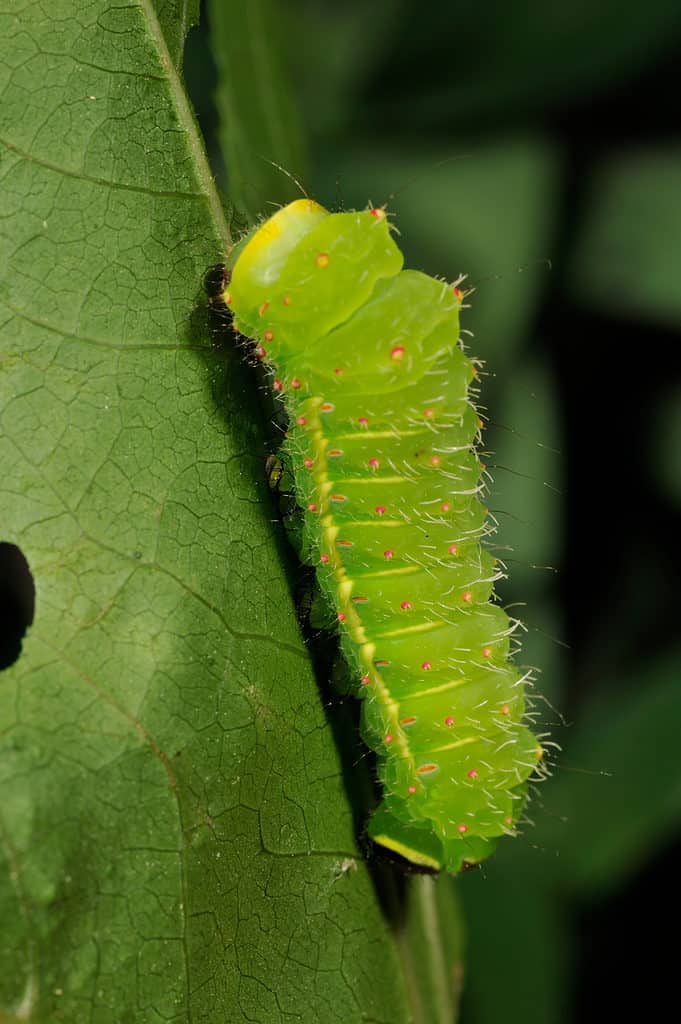
The luna moth caterpillar looks and eats like the main character in
The Hungry Caterpillar.
©Breck P. Kent/Shutterstock.com
Appearance: Lime green with a series of red and orange spots along its sides and white horizontal stripes on their rear ends
Size: 3 – 4.5 inches long
Habitat: Deciduous hardwood forests
Diet: White birch, persimmons, hickories, walnuts, and sumacs.
Dangers: They are harmless to people and animals
Interesting Fact: It’s name is derived from the oval-shaped spots on its wings that are similar to the moon.
13. Eastern Tiger Swallowtail (Papilio glaucus)
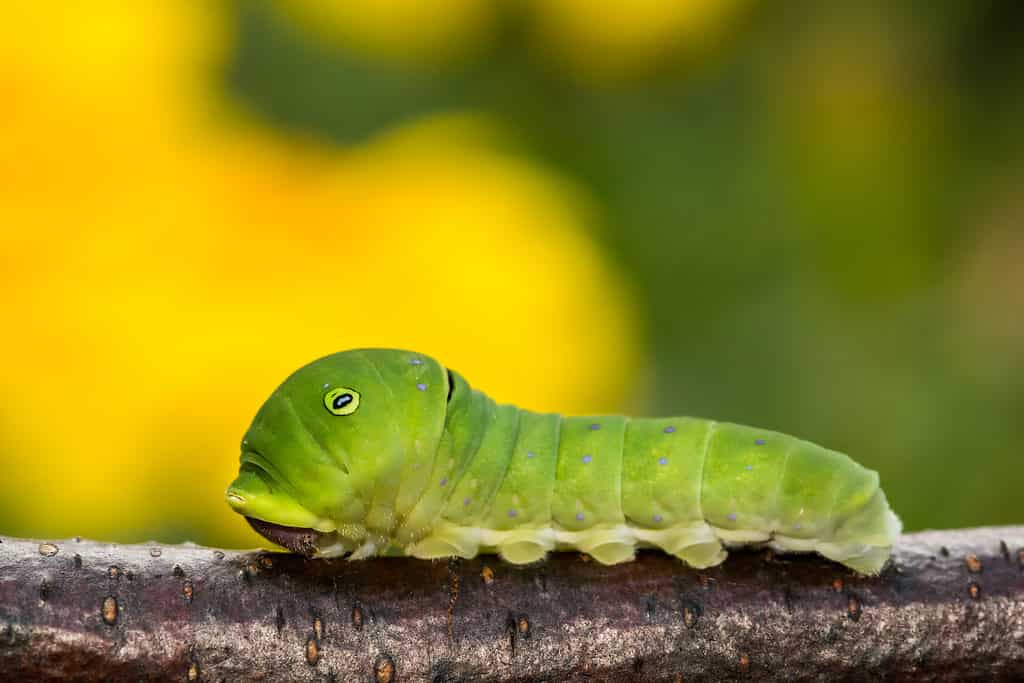
The Eastern
tiger
swallowtail is one of the most commonly seen butterflies.
©Jay Ondreicka/Shutterstock.com
Appearance: Bright green with large yellow and black decoy eyes and orange horns they can extend whenever they feel threatened
Size: 2.2 inches long
Habitat: Woodlands, along streams and rivers, in swamps and wetlands, and in suburban and urban areas
Diet: Cottonwood, ash, birch, wild black cherry, tulip tree, magnolia, and willow trees. They also dine on plants from the genus Aristolochia like Dutchman’s Pipe.
Dangers: It is highly poisonous to most animals and can cause kidney failure in dogs and cats if eaten. They can cause skin irritation or a rash if handled.
Interesting Fact: They shoot out a horrible smell when they feel threatened to further confuse their predators.
14. Hummingbird Clearwing Caterpillar (Hemaris thysbe)
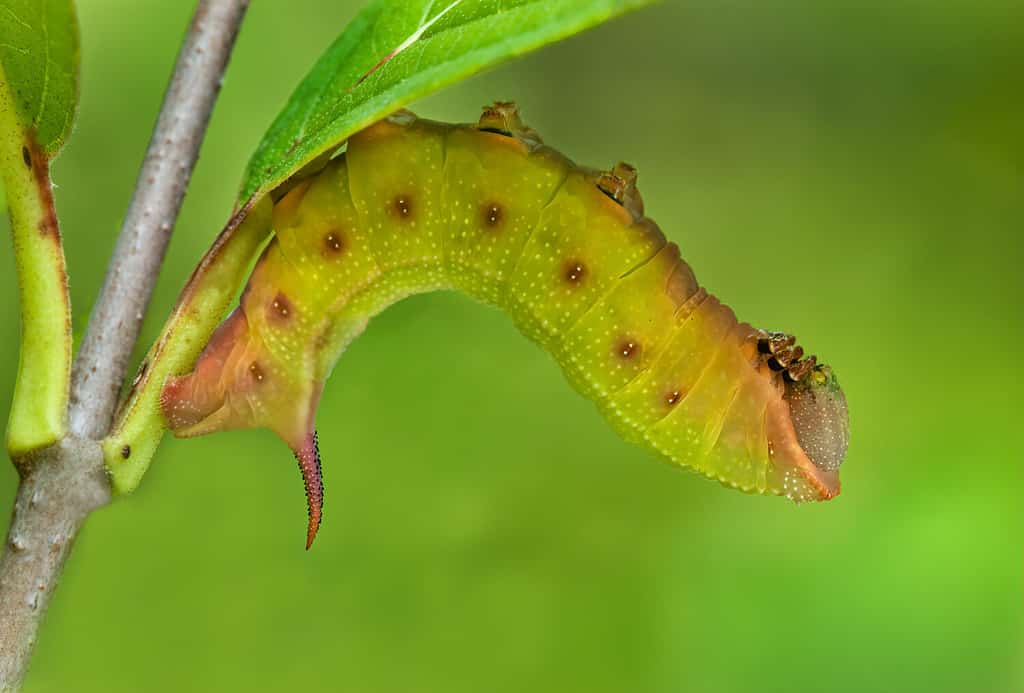
The
hummingbird
clearwing is one of the most unique looking moths.
©Gerry Bishop/Shutterstock.com
Appearance: Plump yellowish-brown to bright green with a horn on its rear end.
Size: 1 – 2 inches long
Habitat: Gardens, meadows, fields, and urban areas.
Diet: Honeysuckle, cherries and plums, snowberry, blueberry, rose, hawthorn, and European cranberry bush
Dangers: They are not poisonous or venomous to humans or pets. They are harmless.
Interesting Fact: The hummingbird clearing moth is one of the primary pollinators for types of orchids.
15. Cecropia Moth (Hyalophora cecropia)
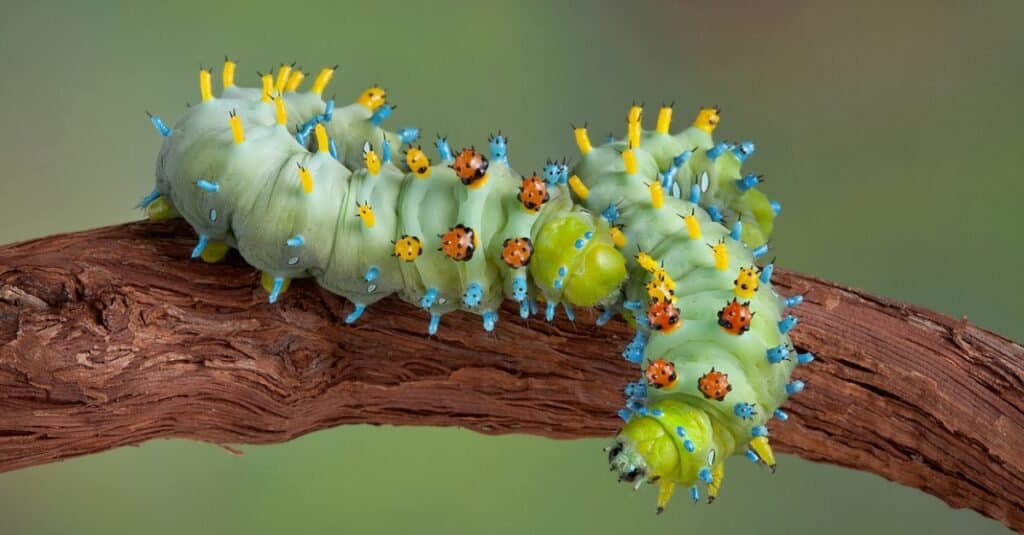
The cecropia moth caterpillar is a colorful member of the giant silk moth family.
©Cathy Keifer/Shutterstock.com
Appearance: Light bluish-green with a bright green head and rear end. They have rows of red, yellow, and blue spiny protrusions on its body with black hairs sticking out.
Size: 5 inches long
Habitat: Near rivers, creeks, wet meadows, or swamps east of the Rocky Mountains.
Diet: Many shrubs and trees like maple, birch, and apple.
Dangers: They rely solely on their scary looks to ward off predators. They are not venomous or poisonous.
Interesting Fact: The cecropia moth can have a seven-inch wingspan.
16. Hickory Horned Devil Caterpillar or Regal Moth Caterpillar (Citheronia regalis)

The average hickory horned devil is nearly 6 inches long!
©Matt Jeppson/Shutterstock.com
Appearance: Bright green with black protruding spikes. Their face and rear end are bright orange, along with their horns, except those are black-tipped.
Size: Up to 6 inches long
Habitat: These caterpillars love walnut trees; when those aren’t readily available, they pick another hickory-type tree to feast on. They remain there until their metamorphosis is complete.
Diet: Persimmon leaves, hickory-type trees, such as walnuts, pecans, buttonbush, filbert, and ash.
Dangers: Despite their appearance, they are neither harmful nor poisonous.
Interesting Fact: The regal moth has a wingspan of 3.75 – 6.1 inches wide, making it the largest moth in North America.
17. Spotted Apatelodes Caterpillar (Apatelodes torrefacta)

The sensational long coat of hair on the spotted apatelodes caterpillar makes it easy to identify and also easy to love.
©Jacy Lucier / CC BY-SA 4.0 – License
Appearance: Small, white, or pale yellow and has very long, fine white or pale yellow hair in abundance, making it look not much like a caterpillar or any creature. It also has black dots, black hair growing along its body, and black antennae. It also has black tentacles on its rear end.
Size: 2.5 inches long
Habitat: These caterpillars can be found anywhere their host trees exist, though forests are generally their habitat.
Diet: Oak, cherry, maple, and ash trees
Dangers: The delicate white hairs of the caterpillar can get under your skin, literally, and cause severe irritation.
Interesting Fact: Its nickname is dragon moth because it resembles a small dragon from the back.
18. Parsley Caterpillar or Black Swallowtail (Papilio polyxenes)
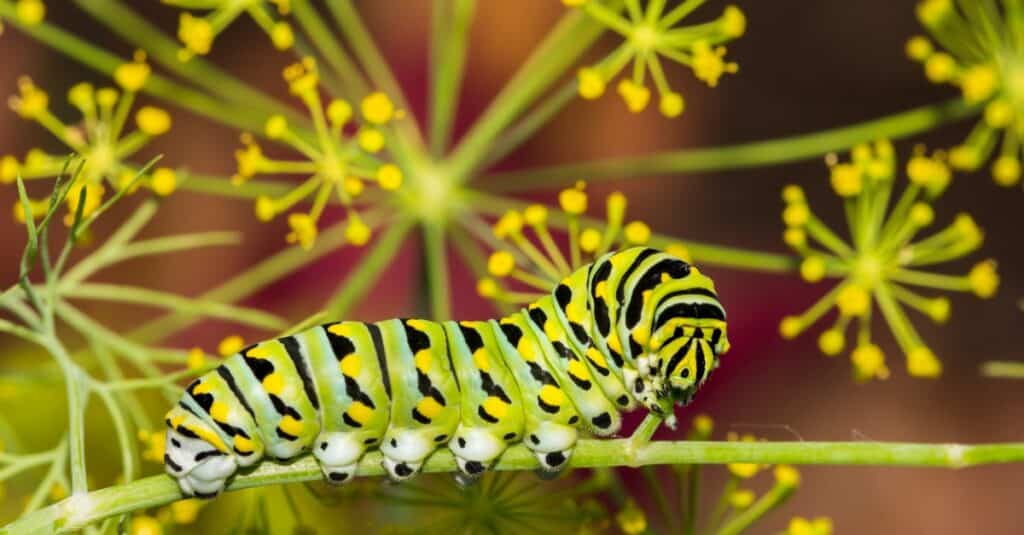
The parsley caterpillar is dressed like bird droppings to gross out predators.
©Jay Ondreicka/Shutterstock.com
Appearance: Bright green and black striped caterpillar with white dots along the black stripes. They are disguised as bird droppings to help escape predators.
Size: 1.5 inches long
Habitat: They sometimes live in gardens that contain the plants they enjoy eating. Otherwise, they can be found on these plants growing in the wild near streams.
Diet: Naturally, the “parsley caterpillar” loves parsley plants along with dill, fennel, lovage, citrus, carrots, celery, and Queen Anne’s Lace.
Dangers: They eat many poisonous plants to make themselves taste bad to predators.
Interesting Fact: The caterpillars also have an osmeterium, a defense organ that looks like a deeply forked tongue. When they feel threatened, it sticks out from the body and dispels a stinky smell, hopefully dissuading predators from attempting to eat them.
19. Red Admiral (Vanessa atalanta)
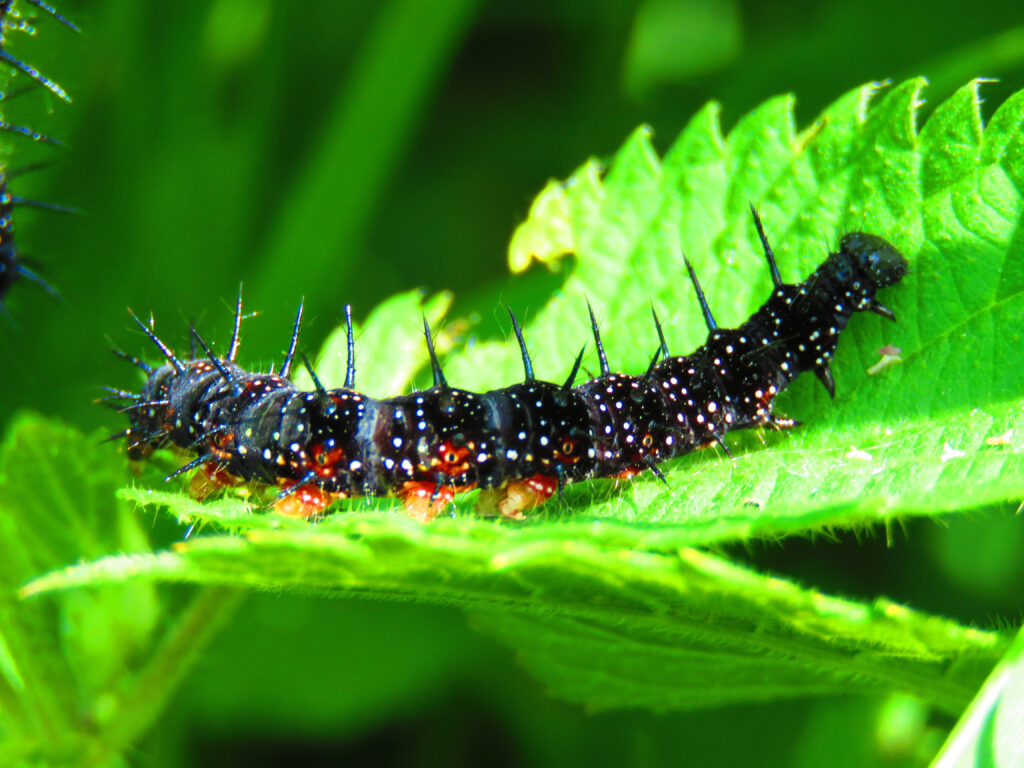
Red Admiral butterflies belong to the largest type of
butterfly
, Nymphalidae or Brush-footed butterflies.
©Przemyslaw Muszynski/Shutterstock.com
Appearance: Black spiky caterpillar with red upper leg and yellow lower with white spots covering its body.
Size: 1 1/4 inches long
Habitat: Since the caterpillars feed on nettles and nettles are generally found near rivers, it’s safe to say these caterpillars are riverbank dwellers.
Diet: Their food of choice is nettles, stinging, and otherwise.
Dangers: They are entirely safe to hold and are not spiky like they look.
Interesting Fact: As butterflies, their two front legs are covered in bristles and small, so they use their other four legs to walk.
20. Large Tolype Moth Caterpillar (Tolype velleda)

This innocent-looking caterpillar is very poisonous.
©B. Kelly Swanson/Shutterstock.com
Appearance: Pale greyish-green with white diamonds on its back. It has tiny bumps along its back with fine white hairs protruding.
Size: 1.7 inches long
Habitat: Farmland, brush, urban areas, gardens, and forests.
Diet: Apple, ash, birch, elm, oak, plum, and citrus trees. They are known to cause severe agricultural damage to crops.
Dangers: The caterpillars are covered in sharp spines that cause massive irritation to human skin. They are also poisonous if eaten by animals or humans. If ingested, they cause diarrhea, nausea, and vomiting. In extreme cases, it can cause kidney failure. There is no antidote.
Interesting Fact: This giant moth has protruding mouth parts and is sometimes called a “snout mouth.”
21. Virginia Creeper Sphinx Caterpillar (Darapsa myron)

All sphinx moth caterpillars have a horn on their rear ends, giving them their name.
©Jay Ondreicka/Shutterstock.com
Appearance: Chunky, lime green caterpillar with white diamonds on its back, a white line pattern on its side, with tiny orange diamonds on each white segment. It is covered in little white dots and has a horn on its rear end.
Size: 3 1/2 inches long
Habitat: These caterpillars in Virginia prefer to stick close to their favorite meals in the brush or vineyard.
Diet: Naturally, their favorite meal is that of the Virginia Creeper, though they also like grape leaves. They are nocturnal feasters. They have also been spotted feasting on leafy greens in gardens.
Dangers: The sphinx caterpillar is not poisonous or venomous, though it can irritate human skin.
Interesting Fact: The sphinx moth is responsible for pollinating many different types of plants.
22. Monarch Caterpillar (Danaus plexippus)

Milkweed flowers are popular food for caterpillars which makes them toxic to predators, but not humans.
©Cathy Keifer/Shutterstock.com
Appearance: Plump, yellow, black, and white striped caterpillar with long thin black antennae. They also have antenna-looking tentacles near their rear end. It also has very pronounced white prolegs and black legs and feet.
Size: 2 inches long
Habitat: They typically stay on the plant or tree they are eating and spin their cocoons there. Most often, this occurs on or very near a milkweed plant.
Diet: Milkweed flowers and plants help keep them safe from predators due to their toxic nature. They also enjoy cherry, oak, and birch trees.
Dangers: The monarch caterpillar’s belly full of poisonous milkweed is harmful to most animals.
Interesting Fact: These caterpillars molt five times before becoming pupa.
Summary of 22 Caterpillars Found in Virginia
| Number | Caterpillar | Length in Inches |
|---|---|---|
| 1 | Saddle-Back Caterpillar | 1 |
| 2 | Monkey Slug | .78 – 1.10 |
| 3 | Hackberry Leaf Slug | 3/8 – 1 |
| 4 | Io Moth | 2 – 2.5 |
| 5 | Buck Moth | 2.5 |
| 6 | Southern Flannel Moth | 1.6 |
| 7 | White-Marked Tussock Caterpillar | 1 – 1.5 |
| 8 | Viceroy Caterpillar | 1.5 – 2 |
| 9 | Eastern Tent Caterpillar | 2 |
| 10 | Woolly Bear | 2 |
| 11 | Giant Leopard Moth Caterpillar | 2 |
| 12 | Luna Moth | 3 – 4.5 |
| 13 | Eastern Tiger Swallowtail | 2.2 |
| 14 | Hummingbird Clearwing Caterpillar | 1 – 2 |
| 15 | Cecropia Moth | 5 |
| 16 | Hickory Horned Devil Caterpillar | Up to 6 |
| 17 | Spotted Apatelodes Caterpillar | 2.5 |
| 18 | Parsley Caterpillar | 1.5 |
| 19 | Red Admiral | 1.25 |
| 20 | Large Tolype Moth Caterpillar | 1.7 |
| 21 | Virginia Creeper Sphinx Caterpillar | 3.5 |
| 22 | Monarch Caterpillar | 2 |
The photo featured at the top of this post is © Sari ONeal/Shutterstock.com
Thank you for reading! Have some feedback for us? Contact the AZ Animals editorial team.






